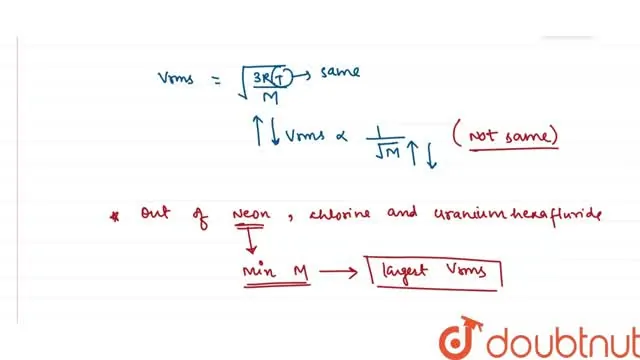Three vessel of equal capacity have gases at the same temperature and pressure. The first vessel contains neon (monoatomic), the second contains chlorine (diatomic), and the third contains uranium hexafluoride (polyatomic). Do the vessels contains equal number of respectice molecules ? Is the root mean square speed of molecules the same in the three cases ? If not, which case is vrms the largest?
Yes. All contain the same number of the respective molecules.
No. The root mean square speed of neon is the largest.
Since the three vessels have the same capacity, they have the same volume.
Hence, each gas has the same pressure, volume, and temperature.
According to Avogadro’s law, the three vessels will contain an equal number of the respective molecules. This number is equal to Avogadro’s number, N=6.023×1023.
The root mean square speed (vrms) of a gas of mass m, and temperature T, is given by the relation: vrms=√3kTm
Where, k is Boltzmann constant
For the given gases, k and T are constants.
Hence vrms depends only on the mass of the atoms, i.e.,
vrms∝√1m Therefore, the root mean square speed of the molecules in the three cases is not the same. Among neon, chlorine, and uranium hexafluoride, the mass of neon is the smallest. Hence, neon has the largest root mean square speed among the given gases.
Related Playlists
Similar Questions
Three vessels of equal capacity have gases at same temperature and pressure. The first vessel contains neon (monoatomic). The second contains chlorine (diatomic) and the third contains uranium hexafluoric (polyatomic). Do the vessels contain equal number of respective molecules ? Is the root-mean-square speed of molecules the same in the three cases? If not, in which case is Ums the largest ?
View SolutionA closed vessel contains equal number of molecule of hydrogen and oxygen. A fine hole is made in the vessel. Which gas will leak rapidly?
View SolutionEqual volumes of gases at the same temperature and pressure contain equal number of particles. This statement is a direct consequence of
View SolutionEqual volumes of all gases under the same conditions of temperature and pressure contain equal number of
View SolutionTwo flask of equal volumes contains N2 and O2 gases at the same temperature and pressure. Which will have greater number of molecules?
View SolutionA closed vessel contains equal number of nitrogen and oxygen molecules at pressure of Pmm. If nitrogen is removed from the system, then the pressure will be:
View SolutionAssertion At the same temperature and pressure, equal volums of all gases gases contain equal numbe of molecules.
Reason In 1 L at NTP total number of molecules are 6.02×1023.View SolutionA mixture of two gases is contained in a vessel. The Gas 1 is monoatomic and gas 2 is diatomic and the ratio of their molecular masses M 1 /M 2 =1/4. the ratio of root mean square speeds of the molecules of two gases is
View SolutionTwo identical vessels contain two different ideal gases at the same temperature. If the average speed of gas molecules in the first vessel is euqal to the most probable speed of molecules in the second vessel, then the ratio of the mass of gas molecules in the first vessel to that in the second vessel is
View SolutionThere are three containers of equal capacity and all are completely filled with mixtures of acid and water in different ratios. The ratio of acid to water in the first container is 2 : 3, in the second container the ratio is 3:7 and in the third container it is 4:11. If the mixtures of all the three containers are mixed together, what will be the ratio of acid to water in it?
View Solution


